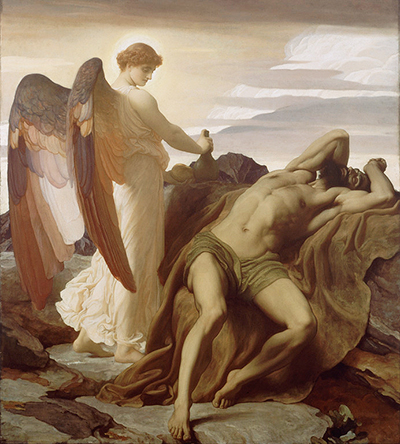Frederic Leighton was a painter in his cadre; known for his avid love for historical events. His speciality lied in Biblical journeys. He lived through the liberalisation of art in the United Kingdom, which earned him honours in the artistic field.
Elijah in the Wilderness was done at a time when he was the President of the Royal Academy; one of the most prestigious Art Institution in the United Kingdom. It was a painting done in 1877/8 by oil on canvas. The original painting was 2343 millimetres high, and 2104 wide. It showed a man (presumably Elijah) laying helplessly on a rock. He is only covered with soft linen around his groins. The man looks exhausted from the heat of the son, evident from the clear skies above.
Besides him is an angelic figure dressed in white with wings. The creature has a jar of water and bread in its hands, looking down on Elijah. Biblically, this is interpreted as God’s messenger looking after His servant after being left in the wilderness to die. Such a painting is one of the more paintings done by Frederic Leighton based on religious teachings. Other paintings done around this time within and without the religious art include The Music Lesson (1877), Nausicaa (1878), Winding the Skein (1878) and Light of the Harem (1880). He was also a gifted sculptor with notable works like the An Athlete Wrestling with a Python (1877) and the Sluggard.
He sharpened his religious artistic skills from Eduard von Steinle, a famous historical painter and Giovanni Costa, a well-known Italian landscape artist. His first piece of art was the portrait of Arthur Schopenhauer. He grew his talent at the Accademia di Belle Arti di Firenze (The Florence Academy of Fine arts), the Pre-Raphaelites and the Royal Academy. His style transcended through Academicism (from which Elijah in the Wilderness was done), Pre-Raphaelite and Aestheticism.
Over time, he met Jean-Auguste Ingres, a Franco Neo-classical painter, Ferdinand Eugene Delacroix and Jean-François Millet. All these artists had the same style of painting. On the other hand, Leighton’s work was inspirational to James Whistler, Sir John Millais and Earl Shinn. His paintings found an audience with influential personalities including Queen Victoria in 1855. Some of his accolades include becoming the President of the Royal Arts Academy. This is besides being a Baron; a fete of which he is the only fine artist to ever hold. Elijah in the Wildernesses was painted while at the Royal Academy and symbolises maturity in his artistic career. The original painting has exchanged hands severally but is currently housed at the Walker Art Gallery in Liverpool, United Kingdom.




